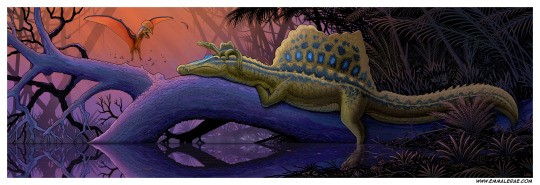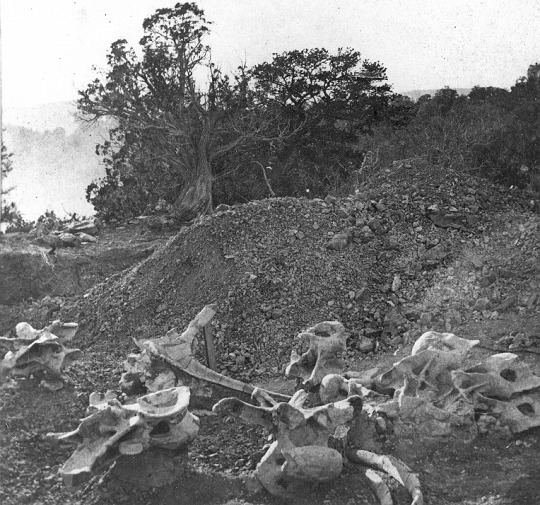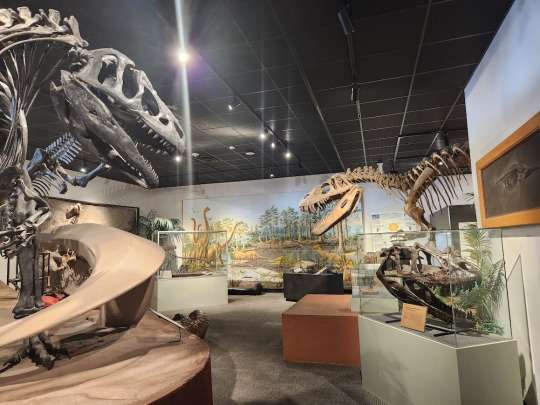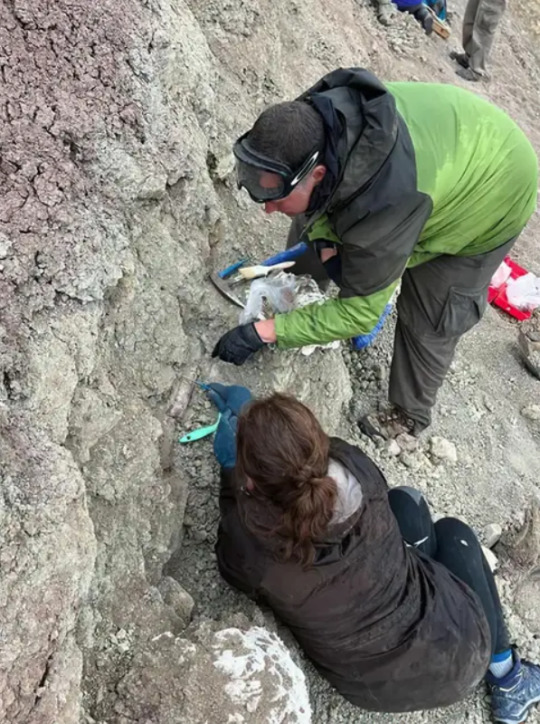#society of vertebrate paleontology
Explore tagged Tumblr posts
Text
So the Preliminary SVP Schedule got released
For those unfamiliar, SVP = Society of Vertebrate Paleontology
usually when paleontologists say "SVP" they mean specifically the conference that SVP hosts each year, one of the biggest events for the "spends their lives studying old bones" people each year
each day has six sessions - three in the morning, three in the afternoon - and they're packed with talks. like, if you want to see talks in two different concurrent sessions, you gotta run around like a maniac
anyways
Wednesday Morning has Sauropods & Ornithischians, Early Mammals & Carnivorans, and then Fishes & Amphibians as three different sessions (all of these are groups of three going forward)
Wednesday afternoon has Dinosaur Soft Tissues, Ungulates, and Marine Reptiles
Thursday Morning has Romer Prize (fancy student talks), Birds, and Preparators' Session
Thursday afternoon has Theropod Flight Origins, Mammal Paleoecology, and Sauropsids
Friday morning has Euarchontoglires & Xenarthra, Archosaurs, and Methods & Paleohistology
Friday afternoon has Actinopterygians, Crocodylomorphs & Turtles, and Paleoecology & Paleoclimatology
Saturday morning has Theropods I, Afrotheria & Mammal Macroevolution, and Synapsids
and Saturday afternoon has Theropods II, Marine Mammals & Bats, and Squamates
The fact that Theropods get four separate focused sessions while Ornithischians and Sauropods are smushed into one is... well, I'm laughing my head off at Theropod bias right now
would you like theropods? Or more theropods? How about some THEROPODS
78 notes
·
View notes
Text
I already put this in the replies but in case of... something. OP said this happened with Australian fossil and this lines up with when the Society of Vertebrate Palaeontology was in Brisbane.
Don't know if this or anything like that happened there. But I know it was a big opportunity for Australian geologist to showcase their work. Some where groundbreaking (literally), others... Okay I'm not THAT deep in the Australian geology lore but I can tell our geologist have a certain... vibe... to them. Like that one animal named after someone saying "wakie wakie" and Kollikodon almost being HotCrossBunodon.
shout out to geologists.
fucking crazy discourse.
I once sat in at a geology talk where these guys found fossils that disproved something about when plants and stuff started to come in the fossil record and they found evidence it was like 20 something million years more than previously thought.
and basically everyone but me like 2 others were like scoffing and like mad? at these people for some reason.
it was super interesting as fuck, I wish I knew more about geology at the time. but fossils it was so cool.
crazy shit.
geologists love you so fucking much I am making out with you.
#geology#paleontology#academia#science#earth science#plant#life#fossil#fossil record#australia#australian science#australian geology#australian paleontology#svp#svp 2019#society of vertebrate paleontology
156 notes
·
View notes
Text

First discovered in the 1850s, Compsognathus longipes was the first theropod dinosaur known from a fairly complete skeleton, and also the smallest known non-avian dinosaur for over 130 years.
(A second specimen was also, briefly, the "first" aquatic non-avian dinosaur, but that's another story.)
Living in what is now Europe during the late Jurassic, about 150 million years ago, it was a lightly built animal with long legs and a long tail, growing to around 1.2m long (~4'). Its hands seem to have had only two functional fingers, with the third being vestigial and possibly not even having a claw.
Skin impressions from about a third of the way along its tail show small bumpy scales – but since other compsognathids like Sinosauropteryx are known to have been covered in fur-like feathers, this likely means that just that particular region of Compsognathus' body wasn't fluffy.
Some of Compsognathus' diet is known for certain, since preserved gut contents show it fed on smaller vertebrates like lizards and rhynchocephalians. The remains of a lizard in the stomach of one specimen were even identified as belonging to a previously-unknown species, Schoenesmahl dyspepsia, with the dismembered nature of the skeleton suggesting Compsognathus tore its prey into bite-sized chunks in a similar manner to modern predatory birds.
———
NixIllustration.com | Tumblr | Patreon
References:
Conrad, Jack L. "A new lizard (Squamata) was the last meal of Compsognathus (Theropoda: Dinosauria) and is a holotype in a holotype." Zoological Journal of the Linnean Society 183.3 (2018): 584-634. https://doi.org/10.1093/zoolinnean/zlx055
Gishlick, Alan D., and Jacques A. Gauthier. "On the manual morphology of Compsognathus longipes and its bearing on the diagnosis of Compsognathidae." Zoological Journal of the Linnean Society 149.4 (2007): 569-581. https://doi.org/10.1111/j.1096-3642.2007.00269.x
Peyer, Karin. "A reconsideration of Compsognathus from the Upper Tithonian of Canjuers, southeastern France." Journal of Vertebrate Paleontology 26.4 (2006): 879-896. https://www.jstor.org/stable/4524640
Wikipedia contributors. “Compsognathus.” Wikipedia, 17 Jun. 2024, https://en.wikipedia.org/wiki/Compsognathus
#science illustration#paleontology#paleoart#palaeoblr#compsognathus#compsognathidae#theropod#dinosaur#art
531 notes
·
View notes
Text




Badlands Dinosaur Museum posters from the 84th annual meeting of the Society of Vertebrate Paleontology.
#badlands dinosaur museum#svp2024#svp#paleontology#palaeontology#paleoblr#palaeoblr#fossils#dinosaurs#fossil#science#dinosaur eggs
86 notes
·
View notes
Text

This is the finished Spinosaurus piece in all its glory! I did this piece to have something special for The Society of Vertebrate Paleontology conference.
The Allosaurus/Diplodocus piece was the intended artwork for the conference, but art is fickle.
13" x 38" prints are now available for purchase on my website.
www.emmalerae.com
470 notes
·
View notes
Text
Dinovember day 30: Saurophaganax

So, huh, "Saurophanax" (the lord of lizard eater) is in a weird spot for now In the recent Cau phylogeny, saurophaganax was placed as a methriacanthosaurid (like the one on the bottom right) BUT in the 84th Society of Vertebrate Paleontology annual meeting, a still unpublished paper stated that some parts of the holotype of "Saurophaganax" where in fact Allosaurus remains (like the pubis part in the bottom of the top left corner and represented on the top right), unidentified large theropod remains (like the metatarsals on the top left) and saupod remains (like the bone on the top right of the top left corner).
I decided to interpret the sauropod remains as those of a camarasaurid, because no one can stop me
@1dinodaily

#dinovember#dinovember2024#paleoart#art#saurophaganax#dinosaur#paleontology#sauropod#metriacanthosaurus#allosaurus#84th svp meeting#camarasaurus#fossils
39 notes
·
View notes
Text
A new proto-tropicbird, Prophaethon waltonensis, has been described in Historical Biology. As I am currently busy attending the annual Society of Vertebrate Paleontology conference, I will write an entry for P. waltonensis next week (along with any other dinosaurs that might potentially be named this week).
34 notes
·
View notes
Text
FOSSIL FRIDAY: CERATOSAURUS
Ceratosaurus, the "horned lizard" is probably one of the coolest dinosaurs discovered. It was described by Othniel Charles Marsh based on a nearly complete specimen from Garden Park, Colorado.

It is one of four large theropods in the Morrison Formation of the U.S. and the Lourina Formation of Portugal. There is currently only one accepted species: Ceratosaurus nasicornis.

Allosaurus, Torvosaurus and Ceratosaurus at the BYU Museum of Paleontology.
Ceratosaurus is a medium-sized theropod. The type specimen is about 17 ft (5.3 m) long but other specimens indicate it could get more than 20 ft long. It is characterized by deep jaws that supported proportionally long, blade-like teeth, a prominent, ridge-like nasal crest, and a pair of crests over the eyes making it appear very dragon-like.

It had fairly short arms especially compared to its contemporary rivals. Each hand had four fingers with the three larger ones sporting a claw.

It also had a row of osteoderms that ran down it's neck, back and tail.
It is thought that Ceratosaurus was a solitary hunter. None have ever been found in close proximity to another. In a paper written by Donald M. Henderson in 1998, he stated that Ceratosaurus' taller skull indicated a resistance to bending. Its long, broad teeth would present increased frictional resistance to penetration due to increased surface area.

It had powerful adductor muscles that would increase the overall stresses on the entire skull. Having a deeper skull would relieve that by increasing the flexural rigidity and thus the strength. Think pit bull or hyena.

Ceratosaurus is only represented by a handful of specimens, far more common than Torvosaurus but still much less common than Allosaurus. There are two ideas floating around about why this is. One, there simply weren't as many of them. Two, it preferred a habitat that just didn't preserve fossils as well. Whatever the case may be, I hope that we can help answer some of these questions with the potential specimen we found at the Evil Tree Bonebed.

Possible Ceratosaur ischium (and it's a whopper for size).
Want to help recover the Ceratosaurus? Then come join us this summer at Colorado Northwestern Community College! Check out the link for more info. Hope to see you there!
66 notes
·
View notes
Text


[ Photos by Derek Fikse and Kara Fikse, showing field team members working at the Cañadón Tomás Quarry. ]
"The discovery of a spectacular fossil site in Argentina is helping shed new light on life at the end of the Cretaceous, the time period just before the non-avian dinosaurs went extinct. New research recently presented at the Geological Society of America’s GSA Connects 2023 meeting by Matthew Lamanna, a paleontologist and the principal dinosaur researcher at Carnegie Museum of Natural History, describes exciting fossil finds from a site known as the Cañadón Tomás Quarry in southern Argentina’s Patagonia region. “In general, dinosaurs and other continental vertebrates from the Cretaceous tend to be less known from the Southern Hemisphere than they are from the Northern, and that creates an imbalance in our understanding of biodiversity, evolution, and paleobiogeography,” says Lamanna. “We know enough about continental vertebrates in the Late Cretaceous to know that there were some very different kinds of animals thriving in the Southern Hemisphere. One thing that we’d really like to know is, how did non-avian dinosaurs in the southern half of the world fare at the Cretaceous-Paleogene boundary?” The Cañadón Tomás site was first discovered in early 2020 due to petroleum interest in the region. Oil companies were required to carry out a paleontological impact study before they could begin work, and the study soon uncovered dinosaur fossils."
Read more: "A Glimpse of Extinction: Scientists Uncover Extraordinary Fossils From the End of the Age of the Dinosaurs" from the Geological Society of America.
#Palaeoblr#Palaeontology#Paleontology#Argentina#Fossils#Dinosaurs#Cretaceous#Mesozoic#Article#Prehistoric#Information#Photos
90 notes
·
View notes
Note
So the week of Halloween this year is also when the society of vertebrate paleontology is meeting - so a lot of people are going to miss the special content! Would it be possible for this year only for it to extend into the first week of November? Would also probably help with USA election anxiety…
You're in luck! the Halloween-themed content will be running from October 21st through November 5th (including those dates)!
14 notes
·
View notes
Text
brb googling "how to get netflix to do a prescreen of Life on Our Planet for us at the biggest vert paleo conference of the year which just happens to be occurring a week before it's supposed to release"
#I am not important enough to make this happen gd dammit#life on our planet#paleontology#svp#society of vertebrate paleontology
40 notes
·
View notes
Text
Correct me if I'm wrong but hasn't the paleo community been talking about lips on t-rex for the past decade almost ?

Why is it an 'unsettling new discovery' ?
Why is rexy 'falling victim' to it ?
Rexy already has more lips than the indominus rex, indoraptor, scorpious rex, giganotosaur and spinosaur combined.
The walking with dinosaurs t-rex had lips.
Its not a new discovery. Yet all of sudden in the past couple days every new outlet and science magazine has been raving about 'scientists now suggest trex had lips' likes it's a new thing.
Robert reisz proposed the idea at the Canadian society of vertebrate paleontology annual meeting on May 20th , 2016. Heck prehistoric planet showed t-rex with lips last year (2022), its not a new discovery.
#i too am burdened with knowledge#ignorance truly is bliss#palaeoblr#prehistoric#dinosaur#dinosaurs#palaeontology#prehistoric planet#prehistoric planet show#walking with dinosaurs#tyrannosaurus rex#t rex#lips#jurassic world dominion#jurassic park#jurassic world#jurassic park the lost world#jurassic park 3#jurassic world fallen kingdom#jurassic world camp cretaceous#jurassic world evolution#jwe#jurassic world evolution 2#dinosaur documentary#dino nerd#dino debates#paleomedia#paleontology#prehistoric park#prehistoric kingdom
17 notes
·
View notes
Text
Meanwhile, at the Society of Vertebrate Paleontology.
youtube
#Skeleton War#Welcome to the Bone Zone#I'm reluctant to actually tag this as paleo#but l've had that title for this song in mynead for years now#Halloween#Youtube#music#Bone Zone#sp00ky#s(@ry#sk€{£+ons#meme
4 notes
·
View notes
Text

Drepanosaurs were a weird little group of tree-climbing Triassic reptiles with prehensile claw-tipped tails, chameleon-like bodies, humped backs, grasping feet, long necks, and somewhat bird-like skulls that may have been tipped with toothless beaks in some species.
Recently some of them have been recognized as also having adaptations for digging and ripping into insect nests, similar to modern anteaters, with highly specialized forelimb bones and a massively enlarged hoked claw on each hand.
And now we have another one of these digging drepanosaurs: Unguinychus onyx, whose name delightfully translates to "claw claw claw"!
Living in what is now New Mexico, USA during the late Triassic, around 215-208 million years ago, Unguinychus is only known from its enlarged hand claws but was probably similar in size to some of its close relatives, likely around 40cm long (~1'4").
Based on skin impressions from the early drepanosaur Kyrgyzsaurus it also would have been covered in small scales, possibly with a skin crest and a chameleon-like throat sac.
Drepanosaurs' evolutionary relationships are rather unclear, with various studies classifying them as an early branch of diapsid reptiles, as close relatives of the gliding kuehneosaurids, or as protorosaurian archosauromorphs. But recently another idea has been proposed, instead placing them slightly further up the archosauromorph evolutionary tree in the allokotosaur lineage close to trilophosaurids – and notably making them very closely related to fellow Triassic bird-headed weirdo Teraterpeton.
———
NixIllustration.com | Tumblr | Patreon
References:
Alifanov, V. R., and E. N. Kurochkin. "Kyrgyzsaurus bukhanchenkoi gen. et sp. nov., a new reptile from the Triassic of southwestern Kyrgyzstan." Paleontological Journal 45 (2011): 639-647. https://www.researchgate.net/publication/257843064_Kyrgyzsaurus_bukhanchenkoi_gen_et_sp_nov_a_New_Reptile_from_the_Triassic_of_Southwestern_Kyrgyzstan
Buffa, Valentin, et al. "‘Birds’ of two feathers: Avicranium renestoi and the paraphyly of bird-headed reptiles (Diapsida:‘Avicephala’)." Zoological Journal of the Linnean Society (2024): zlae050. https://doi.org/10.1093/zoolinnean/zlae050
Jenkins, Xavier A., et al. "Using manual ungual morphology to predict substrate use in the Drepanosauromorpha and the description of a new species." Journal of Vertebrate Paleontology 40.5 (2020): e1810058. https://www.researchgate.net/publication/344545876_Using_Manual_Ungual_Morphology_to_Predict_Substrate_Use_in_the_Drepanosauromorpha_and_the_Description_of_a_New_Species
Pugh, Isaac, et al. "A new drepanosauromorph (Diapsida) from East–Central New Mexico and diversity of drepanosaur morphology and ecology at the Upper Triassic Homestead Site at Garita Creek (Triassic: mid-Norian)." Journal of Vertebrate Paleontology (2024): e2363202. https://doi.org/10.1080/02724634.2024.2363202
#science illustration#paleontology#paleoart#palaeoblr#unguinychus#clawclawclaw#drepanosauridae#drepanosauromorpha#drepanosaur#allokotosauria#maybe#archosauromorpha#reptile#art#triassic weirdos#THE CLAAAWWW
262 notes
·
View notes
Photo
Etymology[edit] The term thagomizer was coined by Gary Larson in jest. In a 1982 The Far Side comic, a group of cavemen are taught by a caveman lecturer that the spikes on a stegosaur's tail were named "after the late Thag Simmons".[3] The term was picked up initially by Kenneth Carpenter, then a paleontologist at the Denver Museum of Nature and Science, who used the term when describing a fossil at the Society of Vertebrate Paleontology Annual Meeting in 1993.[4] Thagomizer has since been adopted as an informal anatomical term[5] and is used by the Smithsonian Institution,[4][6] the Dinosaur National Monument, the book The Complete Dinosaur[7] and the BBC documentary series Planet Dinosaur.[8] The term has also appeared in some technical papers describing stegosaurs and related dinosaurs.[9][10]
It used to take twelve years for a meme to get into circulation is what I'm reading here

Thagomizer
#etymology#via cubicle walls#viva thag simmons#gary larson#the far side#dinosaur#dinosaurs#stegosaurus#wikipedia#meme#protomeme#proto meme#internet science#sociology#academia#the far side is the exact inverse of chick tracts honestly#that's how you earn a species name
4K notes
·
View notes
Text

I will again have a booth and be selling my wares at The Society of Vertebrate Paleontology annual meeting this year in Minneapolis.
8 notes
·
View notes